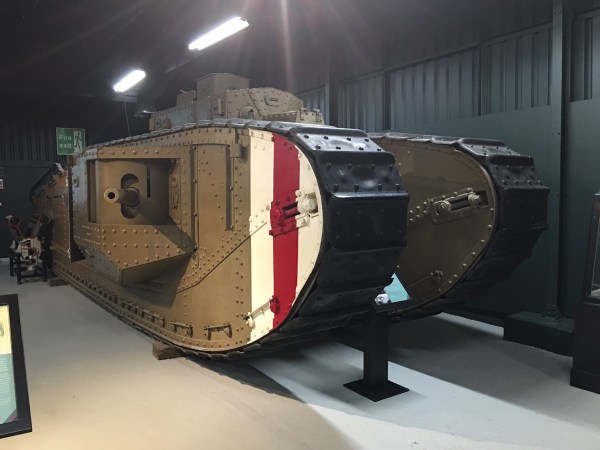This Mark VIII “The International” Tank was on display at Bovington Tank Museum. It is the last remaining survivor of the six Mark VIII tanks which were completed for Britain.

When the United States declared war on Germany in 1917 the US Army started to look at tanks. They favoured the American Renault as their light tank but used British Mark V and Mark V* tanks for their heavy battalion. However they had their own ideas on tank design and, in co-operation with the British Tank Corps came up with a new heavy tank design for 1919.
The Mark VIII tank also known as the Liberty or The International was an Anglo-American tank design of the First World War intended to overcome the limitations of the earlier British designs and be a collaborative effort to equip France, the UK and the US with a single heavy tank design.
Production at a site in France was expected to take advantage of US industrial capacity to produce the automotive elements, with the UK producing the armoured hulls and armament. The planned production levels would have equipped the Allied armies with a very large tank force that would have broken through the German defensive positions in the planned offensive for 1919. In practice manufacture was slow and only a few vehicles were produced before the end of the war in November 1918.
Many people have thought that the tank used in the Indiana Jones and the Last Crusade film was a Mark VIII. However that tank was specially created for the film, inspired though somewhat by the Mark VIII.
film was a Mark VIII. However that tank was specially created for the film, inspired though somewhat by the Mark VIII.

Mechanical effects supervisor George Gibbs said this movie was the most difficult one of his career. He visited a museum to negotiate renting a small French World War I tank, but decided he wanted to make one. The tank was based on the tank Mark VIII, which was thirty-six feet (eleven meters) long, and weighed twenty-five tons. Gibbs built the tank over the framework of a twenty-five ton excavator, and added 6.4 ton tracks, that were driven by two automatic hydraulic pumps, each connected to a Range Rover V8 engine. Gibbs built the tank from steel, rather than aluminum or fiberglass, because it would allow the realistically suspensionless vehicle to endure the rocky surfaces. Unlike its historical counterpart, which had only the two side guns, the tank had a turret gun added as well. It took four months to build, and was transported to Almería on a Short Belfast plane, and then a low loader truck.
I had meant to buy what I thought was a Copplestone Castings’ Mark IX Beast, a similar model of the Indiana Jones tank, but it appeared that it was no longer manufactured or sold by North Star Figures.
So it appeared that it wasn’t even a Copplestones Castings, but was by the Honourable Lead Boiler Suit Company (HLBSCo).
Sometimes you should buy things when you see them and not wait…
So it was originally designed and manufactured by the Honourable Lead Boiler Suit Company (HLBSCo) they were small and relatively new. I even remember discussing licensing the models for a commercial version of Tally Ho!
So I did some searching on the Google and found that the tank is available today with the other HLBSCo models from Empress Miniatures.






















